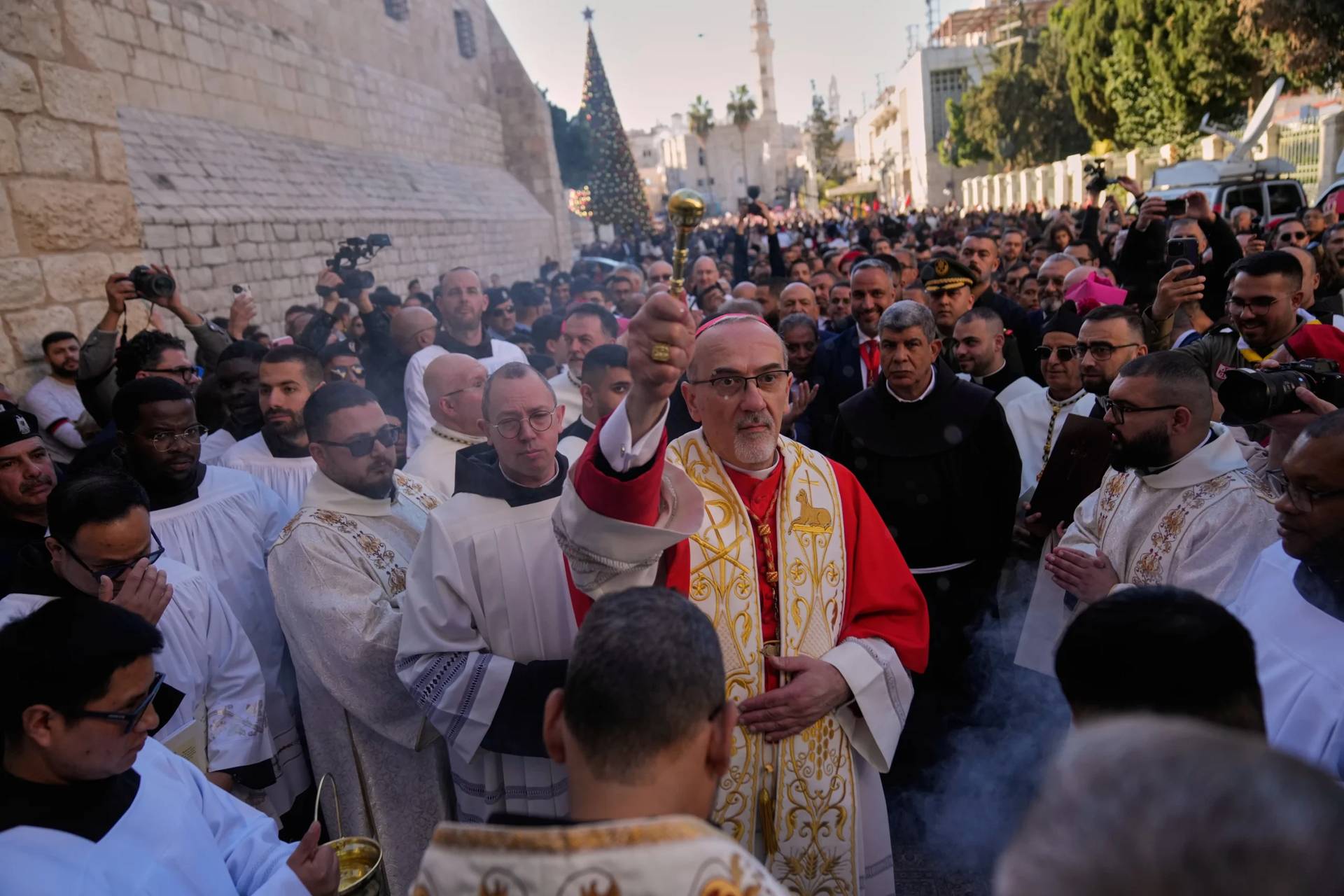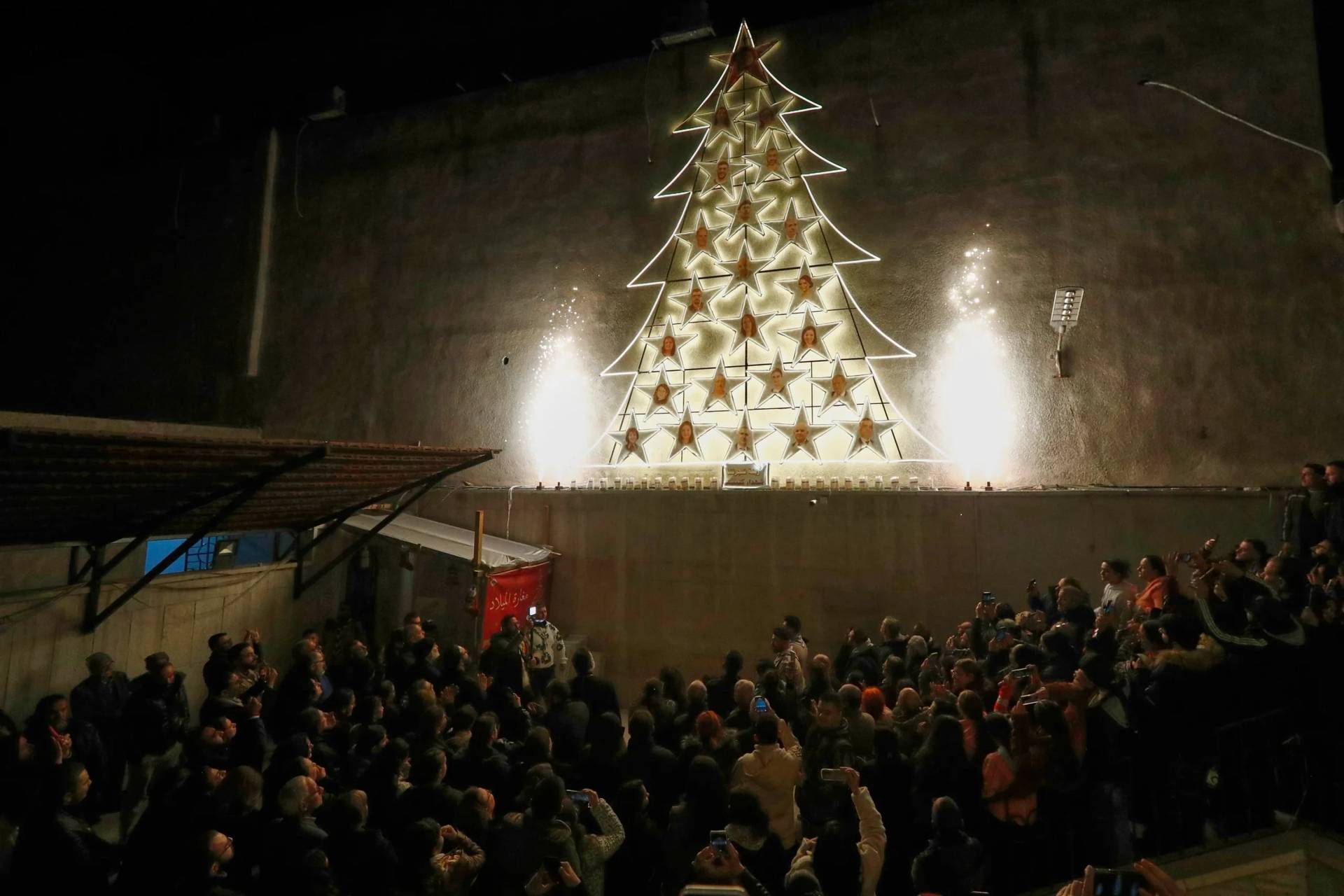MINNEAPOLIS – Hundreds filled the front steps of the Basilica of St. Mary in Minneapolis on November 20 following Mass to witness the closing of the church’s Holy Doors, marking the end of the Catholic Church’s Jubilee Year of Mercy.
Among them were Jonathan Thompson and Julia Waletzko, who had held hands and grinned as they passed through the doors a final time. The pair, who met at the basilica at a Bible study on Valentine’s Day, had gotten engaged just hours earlier.
“The closing of the Holy Doors was a big draw,” Thompson said of the couple’s decision to attend the closing Mass. “It was such a peaceful experience.”
Archbishop Bernard A. Hebda of St. Paul and Minneapolis presided at the evening Mass and then invited the congregation to process out of the Holy Doors before he ceremoniously closed them. With the Cathedral of St. Paul and St. Maron in Minneapolis, the basilica was one of three local churches with designated Holy Doors for the jubilee year.
The ritual was repeated at cathedrals and basilicas across the United States as the Year of Mercy, which began in December 2015, came to a close on the feast of Christ the King.
Pope Francis called for the special year to highlight God’s mercy for all people. Dioceses throughout the world hosted activities focused on the works of mercy, increased time available for confessions and opened designated holy doors for pilgrims.
At the Vatican, as he officially closed the extraordinary jubilee celebration, Pope Francis said: “We have received mercy in order to be merciful.” In his homily, he said that “the true door of mercy, which is the heart of Christ, always remains open wide for us.”
During the year, by passing through a Holy Door, people could receive a plenary indulgence, the remission of temporal punishment due to sin, if they also fulfilled other conditions: reception of the sacraments of penance and the Eucharist, visits and prayers for the intention of the pope and performing simple acts such as visiting the sick.
“Mercy cannot become a mere parenthesis in the life of the church,” the pope wrote in an apostolic letter, “Misericordia et Misera,” (“Mercy and Misery”), which he signed on November 20 at the end of the Year of Mercy.
Cardinal Daniel N. DiNardo of Galveston Houston, president of the U.S. Conference of Catholic Bishops, welcomed the letter.
“Christ’s mercy endures. The healing power of God’s forgiveness is available to all who earnestly seek it,” he said on November 21. “In his apostolic letter … Pope Francis invites us to carry this life-giving message to all who need it. The jubilee year has been filled with grace, a grace that has refreshed our faith for the path of service ahead. … Let us seek out the poor, the sick and all those in spiritual need.”
By sharing what God “has so generously given us” with others, DiNardo said, “we will transform a Year of Mercy into a life of mercy.”
In Washington, Archbishop Timothy P. Broglio of the U.S. Archdiocese of the Military Services celebrated the closing Mass for the special year and closed the Holy Doors at the Basilica of the National Shrine of the Immaculate Conception.
In his homily, he echoed the pope’s words about God’s mercy always being available.
“Closing the Holy Door in no way signifies that divine mercy is no longer available to us,” Broglio said.
“On the contrary, now that we have tasted what the Lord can do for us, the new liturgical year that opens next Sunday should be an invitation to deepen our experience of Christ and hold out his mercy to others.
“It is never too late to beg for mercy from the Lord and no one is beyond redemption. Look up at Jesus and know that he calls us to him,” he said.
In the Archdiocese of Los Angeles, church officials launched two initiatives to mark the close of the jubilee year: Mercy Fund, to support the work of chaplains in prisons and hospitals, and “By Your Side LA,” an outreach to women and men affected by abortion. The initiatives will “continue and expand the mission of mercy” throughout the three counties that make up the archdiocese – Los Angeles, Ventura and Santa Barbara.
“This Year of Mercy has been a special blessing for all of us here in Los Angeles –- a time for rediscovering the great love that God has for us as our heavenly Father and the importance of living with love and mercy toward our brothers and sisters,” said Los Angeles Archbishop Jose H. Gomez.
“As we close the Year of Mercy, we want to give thanks to God for his love and we want to rededicate ourselves to being missionaries of his mercy -– in our homes, in the places where we work, and in every area of our society.”
Hundreds gathered at the Cathedral of Our Lady of the Angels in Los Angeles for the closing Mass celebrated by the archbishop. After Communion, Gomez led Massgoers in a procession outside to the Cathedral Plaza for a final blessing and closing of the “Archway of Mercy.”
In Tennessee, Nashville Bishop David R. Choby celebrated a closing Mass at the Cathedral of the Incarnation. As a final event of the special year, the diocese held a memorial service on November 22 at the Catholic Pastoral Center for those whose loved ones had died in the last year.
“I think people embraced it,” Father Jayd Neely, pastor of St. Mary of the Seven Sorrows Church in downtown Nashville, said of the Year of Mercy. “Mercy is a theme that resonates with everybody.”
Since last May, Aimee Shelide Mayer, program coordinator for social concerns and advocacy at Catholic Charities of Tennessee, organized an event each month reflecting one of the church’s corporal works of mercy.
An event at the Loaves and Fishes program, which provides meals for the poor and homeless, fit well with “feed the hungry,” she said. Another was a drive that collected more than 8,300 diapers for the adoptions assistance program (“I was naked and you clothed me.”) Still another was visiting the homebound through the Living at Home program (“I was in prison and you visited me.”)
In the Archdiocese of Miami, parishioners of St. Mark Church in Southwest Ranches, Florida, marked the closing of the year with a recent six-mile pilgrimage to enter through the Holy Doors at St. Anthony Church in Fort Lauderdale, Florida. Participants included members of the parish’s middle and high school youth groups, along with their families.
St. Anthony was one of six designated pilgrimage churches in the archdiocese for the Jubilee Year of Mercy.
“This is a great finish to the Jubilee Year of Mercy for the youth of St. Mark,” said Father Jaime “Jimmy” Acevedo, St. Mark’s pastor. “We are a pilgrim church to the new Jerusalem, (made) possible only by our merciful God, and what better way than to walk to the Holy Door of mercy.”
In the Diocese of Brooklyn, New York, Auxiliary Bishop Neil E. Tiedemann celebrated a special liturgy with more than 900 people at Regina Pacis Basilica in Bensonhurst. It was one of six diocesan churches that were the sites of Holy Doors throughout the year.
“”We gather in prayer and thanksgiving for the many blessings you and I have experienced as we passed through these doors,” said Tiedemann. “Now you and I are to bring that mercy that we received to the world and we are to be instruments of mercy and forgiveness. We are sent out through the doors of mercy.”
Back in Minneapolis, the jubilee year will forever be part of Thompson and Waletzko’s love story.
Thompson purposely tied his proposal to its final day. Earlier this year, he and his bride-to-be passed through Holy Doors thousands of miles apart, but they concluded the year walking through Holy Doors together.
A parishioner of Maternity of Mary in St. Paul, Thompson went through the basilica’s Holy Doors for the first time on Valentine’s Day and had been praying for clarity in God’s plan for his life.
That night he met Waletzko, a basilica parishioner, who had recently returned from a pilgrimage to the Holy Land where she had gone through Holy Doors at the Basilica of the Annunciation in Nazareth. She, too, had been praying about what God wanted for her life, she said.
“It’s just amazing what happened in the last year, not even, 10 months since I went through those other Holy Doors,” Waletzko told The Catholic Spirit, the archdiocesan newspaper.
In his homily, Hebda emphasized that mercy must continue beyond the jubilee.
“As a people, we have been celebrating throughout this Year of Mercy that our God is a God of mercy and that Jesus, God made flesh, is the very face of mercy,” he said.

















